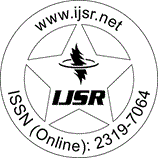Downloads: 109
India | Chemistry | Volume 3 Issue 12, December 2014 | Pages: 1808 - 1811
Effect of Cationic Micelles and Reaction Rates of Bis-2, 4-Dichlorophenyl Phosphate with Hydroxide Ions
Abstract: The reaction of hydroxide ion with bis-2, 4-dichlorophenylphosphate in presence of micelles of cationic, (cetyltrimethyl ammoniumbromidde). Since, the concentration of reactants at micellar surface is a major source of enhancement of rates of bimolecular reactions involving counterions. Therefore effect of added peroxyanions on the above reaction which is strongly catalysed by the micelles of cationic detergent has been extensively studied. For the convenience the micellar rate effects and added peroxyanions have been described under varied experimental conditions of cationic. Kinetic study of micellar catalysed hydrolysis of bis-2, 4-DCPP with different concentrations of [OH-] ion has been carried out at 400.5 0C in aqueous-dioxan mixture (20: 8 v/v) in presence and absence of { [CTAB] [SLS] and [POEDE]} 10-3 mol dm-3 in solutions of borate buffer pH 8.0, 9.0 and 10.0. It has been known much early about the importance of organic phosphate esters as phospholipids, complex lipids (i. e. fatty acid esters containing phosphours, nitrogen bases or sugars) which have been ascribed to sphereical, helical and folded laminr type micelles.1 The most popular types of paste, cream, shampoo are currently employing sodiumlaurylsulphate as the detergent and sodiumsterate as the opacifying cream foaming agent4 and the thicknening agents. Low molecular weight, catonic agents and detergent of the type have been used. A closely related use is, for the treatment of fungal infections in dermatology Cationic surface active agents appear to have same general order of toxicity towards fungi as towards bacteria. The anionic detergents have been found to be effective against gram positive bacteria. A 2 % ointment of sodium lauryl sulphate has been used to promote healing of wounds and udnerlying tissues following festulas of stomach intenstine5 etc. The surface active agents are used in agriculture for two major purpose, the more important of the use in as an ingredient in wide variety of spraying compositions for combating inspects fungi and other enemies of plant life. The second use is in washing fruits and vegetables before marketing in order to remove hazardous spray residues. The residue left after removing mono-2, 4-dichlorophenylphosphate at b6, 120-140C was washed several times with boiling distilled water and 0.2N NaOH solution to remove 2, 4-dichlorophenylphosphate monoester, unreacted phosphorousoxy-trichloride and the phenol are finally digested in hot 0.5N NaOH solution. It was filtered and the filtrate acidified with dilute HC1 using phenolphthalein as an indicator. A white precipitate obtained was separated by filtration and made free from hydroxyl ions with repeated washings with boiling water. It was then dried at room temperature and recrystallised with absolute ethyl alcohol to give a white crystalline solid which was identified to be bis-2, 4-chlorophenylphosphate by the following physical characterisics
Keywords: Miceller Catalyses, 4-CDMPP, CTABr, H2O2, Buffer Solution, Systeronics Spectrophotometer, IR-Spectra, NMR
How to Cite?: Pradeep Kumar, "Effect of Cationic Micelles and Reaction Rates of Bis-2, 4-Dichlorophenyl Phosphate with Hydroxide Ions", Volume 3 Issue 12, December 2014, International Journal of Science and Research (IJSR), Pages: 1808-1811, https://www.ijsr.net/getabstract.php?paperid=1101405, DOI: https://dx.doi.org/10.21275/1101405
